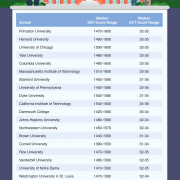It’s just the PSAT, right? As in “pre-SAT”? As in “just practice”?
Wrong.
The PSAT has always been more than “just a practice” test because it also acts as the National Merit Scholarship Qualifying Test (NMSQT), meaning that eligible students who take the PSAT are automatically entered to compete for the prestigious National Merit Scholarship. This alone has long made the PSAT important for a large number of students.
But this year the PSAT is even more important, and not just for top scoring students who hope to compete for scholarships. This year marks the debut of the fully redesigned PSAT, the first real glimpse of what students can expect from the new SAT, which will premiere this spring.
Competing for the National Merit Scholarship
The National Merit Scholarship is a highly prestigious scholarship awarded to just 1% of PSAT test-takers. Worried that you won’t fall into that tiny 1%? Compete anyway! The scholarship is so prestigious that making it to any point in the competition can help with college admissions.
Here’s how the competition works:
- 5 million: The number of eligible students who take the PSAT each year
- 50,000: The number of students designated as “High Scorers”
- 34,000: The number of students designated as “Commended Students”
- 16,000: The number of students who become “Semifinalists”
- 15,000: The number of students who become “Finalists”
- 7,400: The number of National Merit Scholarship recipients
Even making it to “High Scorer” status has perks since you’ll be able to list that accomplishment on your college applications. So even if you don’t ultimately become a scholarship recipient, it’s worth competing.
Get a Sneak Peek of the New SAT
The redesigned SAT premieres this spring, and this is your first (and possibly last) chance to get a sneak peek straight from the College Board. The College Board has not yet released a full-length sample of the redesigned SAT, choosing to limit releases to sample questions rather than full tests. In the past, the PSAT has always been very closely aligned to the SAT. While it’s highly likely that the new SAT will be more difficult than the PSAT (it will, for example, include some high-level math topics that won’t appear on the PSAT), it’s reasonable to expect that the redesigned PSAT will be similar to the redesigned SAT.
Realistic Practice Is Vital
One of the BEST ways to practice for any standardized test is to take practice tests, but the best way to take practice tests is under real-life testing conditions. The PSAT will offer you a chance to get standardized test practice under real-life conditions, complete with coughing students, a watchful proctor, and a loudly ticking clock. By getting used to testing conditions, you set yourself up for success on future tests, including both the SAT and the ACT.
Pinpoint Weak Areas
There is a lot of content overlap between the redesigned PSAT and the redesigned SAT, which means that the PSAT can help you to pinpoint areas in which you might need a bit of a boost. For example, perhaps you’re not too happy with your PSAT math score and your score report shows that you score took a hit because you missed a lot of algebra questions. Since we know that similar algebra questions will appear on the redesigned SAT, this score report gives you plenty of warning that you should practice algebra before you take the SAT.
Score Prediction
In the past, PSAT scores were designed to provide a clear comparison between the PSAT and the SAT: The PSAT was scored out of 240, and the SAT was scored out of 2400, allowing a pretty straightforward comparison. The new PSAT, however, is scored out of 1520; the redesigned SAT is scored out of 1600. This doesn’t allow for such simple linear score comparisons.
So should you use the PSAT to predict SAT scores? Yes and no.
Rather than trying to figure out the SAT equivalent of your PSAT scores, look at your percentile ranking. This number shows where you rank in comparison to all of the other 1.5 million test-takers in the country. Since both the PSAT and the SAT provide scaled scores, your final SAT score is not merely a reflection of how many questions you got wrong or right, but of how well you performed compared to all other test-takers. So if you’re scoring in the 95th percentile on the PSAT, it’s a good bet that you’ll earn a pretty high score on the SAT – a score equal to or higher than 95 percent of the people who took the test that day.
Whether you’re taking the PSAT just for practice or to compete for scholarships, we wish you the best of luck this month!
Click here to learn more about the new PSAT and take a practice test with C2!









